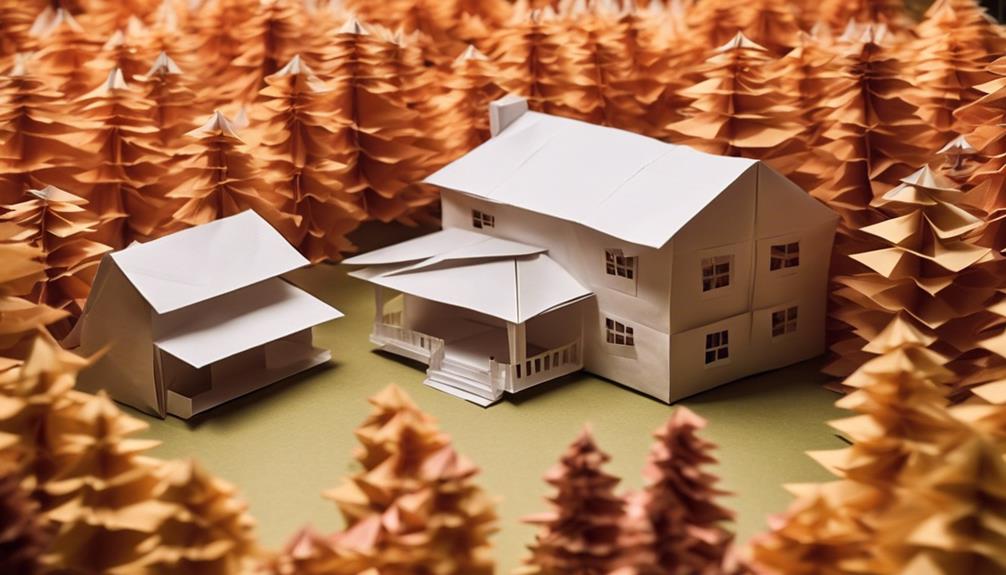In wildfire-prone areas, your home's fire safety measures should be as vital as a sturdy lifeboat on a turbulent sea. Proper precautions can mean the difference between a close call and devastating loss. Consider this: with wildfires on the rise, understanding and implementing key safety strategies is paramount. From creating defensible space to choosing fire-resistant roofing materials, each step you take enhances your home's ability to withstand a potential blaze. So, what can you do to safeguard your property and loved ones from the threat of wildfires?
Defensible Space

To create a defensible space around your home, you must clear all flammable vegetation within a minimum of 30 feet. This step is crucial in reducing the risk of wildfires spreading to your property. Implementing fuel reduction strategies within this area is vital. Trim trees regularly, especially those close to structures, and maintain a well-irrigated and appropriately spaced landscape. Proper landscaping design can act as a barrier, helping to slow the advance of a wildfire towards your home.
In fuel reduction, prioritize the removal of dead plants, dried leaves, and other combustible materials. Regularly dispose of these materials to prevent them from accumulating near your residence. Additionally, consider using fire-resistant plants in your landscaping. These plants are less likely to ignite during a fire, further enhancing the defensibility of your space.
Home Fire Safety Assessment
Clearing flammable vegetation around your home is only the first step; now, let's assess your home's fire safety measures to ensure comprehensive protection. When evaluating your home's fire safety readiness, consider the following:
- Fire Drill: Conducting regular fire drills with your family is crucial for preparedness in case of a fire emergency. Ensure everyone knows the escape routes and meeting points outside the house.
- Smoke Alarms: Check that smoke alarms are installed in key areas of your home, such as bedrooms and hallways. Test them monthly and replace batteries at least once a year to guarantee they are functioning properly.
- Fire Extinguishers: Verify that fire extinguishers are readily accessible in different areas of your home, especially in the kitchen and garage. Make sure everyone knows how to operate them correctly.
Emergency Evacuation Plan

Developing an effective emergency evacuation plan is crucial for ensuring the safety of your household in the event of a wildfire or other emergencies. Begin by creating a detailed evacuation route plan that includes primary and alternative escape routes. Identify safe locations where your family can meet if separated during the evacuation. Regularly practice the evacuation plan with all household members to ensure everyone knows what to do in case of an emergency.
Establish a family communication plan that includes important contact numbers, emergency services, and a designated out-of-area contact person. Ensure that everyone in your household is aware of this plan and knows how to reach each other in case of separation. Utilize mobile phones, walkie-talkies, or other communication devices to stay in touch during emergencies.
Fire-Resistant Roofing Materials
Consider selecting fire-resistant roofing materials to enhance the protection of your home in wildfire-prone areas. When choosing roofing materials, opt for those that not only provide fire resistance but also offer benefits such as energy efficiency and cost-effectiveness. Here are some key points to consider:
- Metal Roofs: Metal roofs are highly fire-resistant and durable. They can withstand flying embers during a wildfire, reducing the likelihood of your roof catching fire.
- Clay or Concrete Tiles: Clay or concrete tiles are another excellent choice for fire resistance. They are heavy and non-combustible, adding an extra layer of protection to your home.
- Asphalt Shingles with Fire Retardant Coating: If you prefer asphalt shingles, consider those with a fire retardant coating. These shingles can provide good fire protection while still being cost-effective.
Ember-Resistant Vents

When selecting vent materials for your home in wildfire-prone areas, opt for ember-resistant options to minimize fire risks. Proper installation techniques are crucial to ensure vents are secure and effectively prevent embers from entering your home. Regular maintenance of these vents is essential for long-term durability and continued protection against wildfire threats.
Vent Material Selection
To enhance your home's fire safety in wildfire-prone areas, prioritize using ember-resistant vents made from durable materials. When selecting vent materials, consider the following:
- Metal Mesh Screens: Opt for vents with fine metal mesh screens to prevent ember entry.
- Non-Combustible Materials: Choose vents made of non-combustible materials like metal or fire-resistant polymers.
- Dual-Purpose Vents: Select dual-purpose vents that not only resist embers but also provide adequate ventilation for your home.
Proper Installation Techniques
For optimal fire safety in wildfire-prone areas, ensure the proper installation of ember-resistant vents by following precise techniques and guidelines. Proper anchoring of ember-resistant vents is crucial to prevent embers from entering your home during a wildfire. When installing these vents, make sure they are securely anchored to the exterior wall using appropriate fasteners. Additionally, pay close attention to ventilation techniques to maintain proper airflow while minimizing the risk of ember intrusion. Properly installed ember-resistant vents not only enhance the overall fire safety of your home but also provide peace of mind during wildfire seasons. By following these installation techniques diligently, you can significantly reduce the vulnerability of your home to wildfires.
Maintenance for Durability
Proper maintenance of ember-resistant vents is essential to ensure their durability and effectiveness in protecting your home from wildfires. To keep your vents in top condition, follow these key steps:
- Rust prevention: Regularly inspect vents for any signs of rust or corrosion. Treat any affected areas promptly to prevent further damage.
- Weatherproofing: Ensure that vents are properly sealed and free of gaps that could allow embers to enter. Consider applying weatherproofing sealant as needed.
- Upkeep: Clean vents regularly to remove any debris or buildup that could impede airflow. Check for any damage and address it promptly to maintain the integrity of the vents.
Proper Vegetation Management

Regularly clearing dead vegetation around your home is essential for reducing the risk of wildfires. Dead vegetation acts as fuel for fires, allowing them to spread quickly and dangerously close to your property. To further mitigate this risk, consider implementing proper vegetation management practices. Utilize landscaping techniques that create defensible space around your home, such as planting fire-resistant plants and keeping grasses well-watered and trimmed. Additionally, incorporating irrigation systems can help maintain moisture levels in your landscaping, making it less susceptible to catching fire.
When managing vegetation, focus on creating a buffer zone around your property by keeping trees pruned and removing dead branches regularly. This will prevent fires from easily reaching your home and give firefighters a better chance of defending it. Remember, effective vegetation management is a crucial step in protecting your home from wildfires, so make it a priority to maintain a fire-safe landscape around your property.
Fire-Resistant Exterior Materials
Consider utilizing fire-resistant exterior materials to enhance the safety of your home in wildfire-prone areas. When selecting materials for your home, focus on those that offer heat insulation properties and durability against flames. Here are some key points to consider:
- Fiber Cement Siding: This type of exterior cladding is highly fire-resistant, offering a protective barrier against heat and flames. It is a durable option that can help prevent the spread of fires to your home's structure.
- Metal Roofing: Metal roofs are known for their fire-resistant properties and can effectively shield your home from airborne embers and radiant heat. They also have a long lifespan, reducing the need for frequent replacements.
- Fire-Resistant Insulation: Insulating materials that are designed to withstand high temperatures can help in preventing the transfer of heat to the interior of your home. Look for insulation options specifically rated for their fire-resistant qualities.
Safe Storage of Flammable Materials

When storing flammable materials, ensure they are kept in designated areas away from your home and other structures. Use approved containers that are designed to safely hold these substances. Proper storage location and container choices are crucial to minimizing fire risks in wildfire-prone areas.
Storage Location Tips
To ensure the safe storage of flammable materials, homeowners in wildfire-prone areas must carefully designate appropriate locations. When considering storage location tips, keep the following in mind:
- Garage Organization and Safety: Store flammable materials in a well-organized manner, away from potential ignition sources such as electrical outlets and vehicles.
- Outdoor Shed Precautions: If storing flammable materials in an outdoor shed, ensure the shed is constructed from fire-resistant materials and located a safe distance away from your home.
- Proximity to Vegetation: Avoid storing flammable materials near vegetation that could easily catch fire during a wildfire.
Proper Container Choices
For the safe storage of flammable materials in wildfire-prone areas, selecting appropriate containers is crucial to minimize fire risk and ensure protection for your property. When choosing containers, consider both functionality and aesthetics. Opt for containers made of non-combustible materials like metal or heavy-duty plastic. These materials can withstand high temperatures and reduce the likelihood of igniting during a wildfire. Additionally, prioritize container size recommendations to prevent overcrowding and allow for adequate spacing between items. Larger containers are preferable as they offer more storage capacity while minimizing the risk of spills or leaks. Remember, the right container choice not only enhances safety but also contributes to the overall fire preparedness of your property.
Community Fire Preparedness
Developing a robust community fire preparedness plan is essential for safeguarding lives and properties in wildfire-prone areas. In order to enhance your community's readiness and response to wildfires, consider the following key strategies:
- Community Drills: Conduct regular community drills to practice evacuation procedures, emergency communication protocols, and coordination with local authorities. These drills help ensure that residents are familiar with the necessary actions to take in the event of a wildfire.
- Preparedness Workshops: Organize workshops that educate community members on wildfire safety, fire mitigation strategies, and how to create defensible spaces around homes. These workshops empower individuals with the knowledge needed to protect themselves and their properties.
- Evacuation Routes and Emergency Shelters: Establish clear evacuation routes that are well-marked and regularly maintained. Identify designated emergency shelters where residents can seek refuge during a wildfire, ensuring that these locations are easily accessible and equipped to support those in need.
Frequently Asked Questions
Are There Any Specific Insurance Considerations for Homeowners in Wildfire-Prone Areas?
When it comes to insurance considerations for homeowners in wildfire-prone areas, it's crucial to understand your coverage and conduct a thorough risk assessment. Insurance policies may have specific provisions related to wildfire damage, so make sure you review them carefully. Emergency preparedness and evacuation planning are also key factors to consider. By being proactive and having a solid plan in place, you can better protect your home and family in the event of a wildfire.
How Often Should Homeowners Inspect and Maintain Their Fire-Resistant Roofing Materials?
Regular inspections and proper maintenance of fire-resistant roofing materials are crucial for your safety. You should inspect your roofing at least twice a year to ensure it remains in optimal condition. Look for any signs of wear, damage, or debris that could compromise its effectiveness. Clean gutters and remove any flammable materials near the roof. By staying vigilant, you can help protect your home from the threat of wildfires.
What Steps Should Homeowners Take to Protect Their Pets During a Wildfire Evacuation?
When it comes to your pets' safety during a wildfire evacuation, it's crucial to have a detailed plan in place. Consider using a simple yet effective symbol: a designated pet evacuation kit. This kit should include essentials like food, water, medications, and comfort items for your furry companions. Additionally, make sure to have a clear evacuation route and a safe meeting point for your pets in case of separation. Prioritizing pet safety in evacuation plans is key.
Are There Any Grants or Funding Opportunities Available to Help Homeowners Implement Fire Safety Measures?
If you're seeking ways to bolster your home's fire safety, there are funding options and assistance programs available to aid in implementing protective measures. Government resources and financial support can be accessed through various grants and programs designed to assist homeowners in wildfire-prone areas. By exploring these avenues, you can find the necessary support to fortify your property against potential fire hazards.
How Can Homeowners Stay Informed About Wildfire Risks and Alerts in Their Area?
To stay informed about wildfire risks and alerts in your area, engage in community outreach programs that provide vital information. Emergency preparedness is crucial, given that 90% of wildfires are caused by humans. Sign up for local alerts, follow official social media accounts, and attend informational sessions. Understanding the risks and being proactive can help you protect your home and loved ones in the event of a wildfire.



